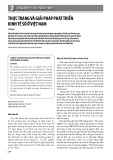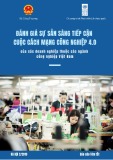
* Corresponding author
E-mail address: rahmanimr@yahoo.com (M. Rahmani)
© 2020 by the authors; licensee Growing Science.
doi: 10.5267/j.uscm.2019.7.003
Uncertain Supply Chain Management 8 (2020) 207–224
Contents lists available at GrowingScience
Uncertain Supply Chain Management
homepage:
www.GrowingScience.com/uscm
Examining the impact of transfers in pickup and delivery systems
Hiva Shiria, Morteza Rahmanib* and Morteza Khakzar Bafrueia,b
aIndustrial Engineering Department, Technology development institute (ACECR), Tehran, Iran
bIndustrial Engineering Department, University of Science and Culture, Tehran, Iran
C H R O N I C L E A B S T R A C T
Article history:
Received June 7, 2019
Received in revised format June
25, 2019
Accepted July 11 2019
Available online
Ju
ly
11
201
9
As an attractive feature for modern transportation systems, the potential of the transfers
capability (the load/passenger transfer between the two vehicles in its route) in reducing costs,
increasing customer satisfaction and increasing the flexibility of the system, has been
approved. But how profitable it could be under different circumstances? In other words, to
which factors its influence depends on? what are its benefits versus its costs? The present
research aimed to give a relatively comprehensive answer to these questions using a
mathematical model of the pickup and delivery system with transfers. According to the model
results under different situations, many factors such as modeling assumptions, system goals,
transportation network scheme, vehicle fleet in terms of capacity, cost rate, and time window
of activity and requests in terms of the length (direct distance between the pickup and delivery
points), time windows and the volume to vehicle capacity ratio, affect the transfers benefits.
As the small-scale numerical results indicate, we have an average of 5.7% reduction in the trip
cost under normal conditions, which increases with the heterogeneity of vehicles, shorter time
windows, and an increase in the length of the request. On the other hand, it is expected that
profitability increases by problem size.
.
, Canada
by the authors; licensee Growing Science
20
20
©
Keywords:
Transfers
Pickup and delivery systems
Mixed integer programming
1. Introduction
Along with urban development, modern transportation systems are trying to reduce costs
(transportation and road depreciation costs), reduce fuel consumption (cost and emissions reductions),
and increase user satisfaction by optimizing usage of road infrastructure and vehicles capacities.
Ridesharing (Lotfi et al., 2019), crowdsourced (Sampaio et al., 2018), mixed passengers and goods
transportation (Godart et al., 2018), etc. are examples of modern pickup and delivery systems. The
transfers capability (the load/passenger transfer between two vehicles in the middle of the route) is a
relatively new feature, which in many cases, it can operationalize system in addition to reducing costs
and increasing the efficiency of these systems. The pickup and delivery problem (PDP) is the
generalization of the Vehicle routing problem (VRP), in which each request (load/passenger) must be
taken from a specified location (origin) and delivered at a different one (destination). The problem
objective is to determine the set of paths within the framework of several constraints so that the requests
can be answered as best as possible. This objective is usually expressed as a combination of the vehicle
cost (the service provider perspective) and the level of customer satisfaction (customer perspective).
Express post service, postal couriers, shipping and carrier companies are the most major stakeholders

208
of PDP. The Pickup and delivery problem with transfers (PDPT) is the extension of PDP in which
requests are allowed to transfer between vehicles in the given places (transfers points); the
load/passenger transfer from one vehicle to another and continuing its route by the new one. By
expanding solution space, transfers capability reduces costs throw optimal use of vehicle capacities,
and increases the system flexibility in cases where it is impossible to meet demand without it. There
could also be some constraints on the real system that require transfers. For example, it is only possible
through transfers to limit the activity of each vehicle (or its driver) to a specific geographical area, while
requests are widespread.
In the Shang and Cuff (1996) model, which firstly introduced PDPT, each network node is a transfer
point. Subsequent research’s in this area has been formed around mathematical modeling and problem-
solving algorithms and techniques. Mues and Pickl (2005) provided a different integer programming
model for the PDPT problem in integrated transport systems. Kerivin et al. (2008) modeled the PDPT
problem with the split-delivery in the form of an integer programming model. A branch and bound
algorithm was also developed, and random problem instances were solved with 5 to 15 requests. Rais
et al. (2014) developed a new mixed integer mathematical programming model for the pickup and
delivery problem with transfers. Thangiah et al. (2007) proposed a meta-heuristic algorithm for solving
the PDPT under dynamic conditions with the split-delivery capability. In Gørtz et al. (2009), the authors
considered the Dial-a-Ride Problem with transfers (DARPT). The transfers capability in a passenger
transportation system can increase its overall productivity. In contrast, it could result in an increase in
passenger dissatisfaction due to transfers operation and longer wait times. Hence, it is necessary to
create a balance between the system flexibility and customer dissatisfaction which is the focus of
research by Cortés et al. (2010). They proposed a mixed integer programming model. The Benders
decomposition method was used to solve a small-scale problem, including six requests, two vehicles
and one transfers point, and the results were compared with the results obtained from the branch and
bound method.
Masson et al. (2011) used the Tabu search algorithm to solve the DARPT. Neighboring heuristic
techniques are commonly used to solve routing problems with time-based constraints. Noting the
dependence of routes in the PDPT, the time needed to determine the feasibility of a solution is one of
the algorithm efficiencies factors. Masson et al. (2013b) proposed a method that allows the
determination of the feasibility of a solution in constant time. In the Bouros et al. (2011) research,
requests are randomly logged into the system and should be assigned to a fleet of vehicles. A two-step
local search algorithm has been used to allocate requests to vehicles. Masson et al. (2013a) used the
Large Neighborhood Search Method to solve the PDPT. According to their results, adding transfers
points improves the objective function by 9% reduction. In a similar study, Masson et al. (2014) used
the Large Neighborhood Search algorithm to solve the DARPT. Until now a fundamental question
remains unanswered; what is and how much is the potential benefits of transfers capability? And what
should be the structure and characteristics of the problem so that these benefits can be realized? The
only research focused directly on this problem is Mitrović-Minić and Laporte (2006) who have partly
answered these question (as noted by Sampaio et al. (2018)). A few researchers have also relatively
responded to this question. Mitrović-Minić and Laporte (2006) is an empirical study on the usefulness
of transfers in the pickup and delivery systems. To evaluate the benefits of transfers, they produced a
sample of 50 and 100 requests in two uniform and clustering scenarios. They did not achieve
satisfactory results from solving random samples with a different number of transfers points. So that,
the addition of a transfer point in this sample does not significantly reduce the total distance traveled
(objective function) relative to the without transfers point mode (between 0% and 7% on average for
samples of 50 requests and between 2% and 10% in the samples of 100 requests). According to their
results, the positive effect of transfers will increase by growth the size of the problem and the time
window. The clustering problems sample results are very tangible (between 0 and 4%, on average,
depending on the cluster). These effects increase with increasing number of transfers points and depend
on the cluster structure. The positive effect of the transfers is increased with shrinking the clusters.
Nakao and Nagamochi (2008) examined the lower bound of traveling cost saved by adding a transfer

H. Shiri et al. /Uncertain Supply Chain Management 8 (2020)
209
point to the PDP. It is assumed that the number of transfers points is one, and each vehicle can visit a
transfer point at most once. There is also no limitation on the number of vehicles. Vehicles have limited
capacity, and the cost is asymmetric for each arc. The vehicle starts its journey from the origin and
returns it, and all requests must be accomplished. Assuming that the z(PDP) is the optimal travel cost
for PDP and z(PDPT) is the optimal cost for PDPT; also, p is the number of requests and m is the
number of routes in the optimal solution of PDPT. They showed that following equations are valid:
(PDP) (6 1 )*z(PDPT)
z m
(PDP) (6 1 )*z(PDPT)
z p
which states that the travel cost saved by transfers can be proportional to the square root of the number
of requests. Cortés et al. (2010) conducted research based on the need to evaluate the Dial-A-Ride
system in two scenarios: with and without transfers. They emphasized the general mathematical
modeling and the ability to find the optimal answer (or the near-optimal answer) as a strict way to
compare the usefulness of methods (with and without transfers). In this study examining the conditions
in which PDPT can produce a better optimal response than PDP has postponed to future, and the results
are limited to the speculation that the usefulness of the transfers operation increases with the increase
in demand. It has been proven in Qu and Bard (2012) that a necessary condition to reduce mileage
along with the transfers in a PDPT, with a vehicle, is that the total customer demand be greater than the
capacity of the vehicle. It is also proven that the transfers can be beneficial in the PDPT with two or
more vehicles, although the capacity of the vehicle is not limited. Masson et al. (2013a) noted the
clustering nature of requests in the sample problems of Li and Lim's (2003), and it is empirically
demonstrated (based on experiment), given that the pickup and delivery points of the majority of
requests are placed in a same cluster, the transfers cannot be so useful. Coltin and Veloso (2014) pointed
out that transfers can have different effects depending on the objective function. For example,
minimizing delivery times in proportion to minimizing costs can have more usefulness potential (more
reduction in the objective function). Based on numerical results, Masson et al. (2014) concluded that
the savings from the transfers, is very different from a sample of DARP to another, and it seems that
the location and number of transfers points can have a negligible effect on it. According to their results,
the reduction of the objective function (minimum cost) as a result of the trip, is close to zero on most
problem samples (when the depot is the transfers place), and when all the point are transfers places, it
varies from 0% to 10%. They reported 1% to 9% cost reduction for real-life cases. Rais et al. (2014)
stated that transfers capability could play a significant role in problems where travel distance and travel
time available to vehicles, are limited. In such situations, requests can be moved between different
vehicles at transfers points so as the limited routes or the maximum possible distances, can be bypassed.
They also noted that their test data (Li & Lim, 2003), are based on a Euclidean-based metric, that
satisfies the triangular inequality, and does not create suitable conditions for the transfers. Also, the
real-world networks may also have a much different cost structure and have a much more impressive
use of transfers. The results of numerical tests in the study of Sampaio et al. (2018), showed that the
introducing of the transfers capability in a crowdsourcing systems can significantly decrease the
traveled mileage as well as the number of drivers required to complete a set of requests, especially
when drivers have a short working time (relative to the planning horizon) and we are faced with long-
haul requests. They analyzed the potential of transfers benefits in the urban pickup and delivery
operations, with a particular focus on the conditions that drivers operate in short shifts (similar to
crowdsourcing models). In this condition the flexibility, provided through the transfers, allows for the
service the long-distance requests that otherwise would have been impossible. To investigate the
potential for transfers capability, they produced a series of random samples and reported in both cases;
with and without transfers, and reported a maximum reduction of 50% of the total distance and number
of vehicles used. When the distance between pickup and delivery point is short, its usefulness is low
and about 1% to 2%, regardless of the length of the driver's shift. Also, the expected utility is reduced,

210
with the increase in the length of the work shift; since with a longer shift, the driver can cover more
distances and make more requests in the same route.
2. Problem definition
There is a fleet of vehicles with capacity, cost rates, and a specific origin and destination depot available
for accomplishing a set of requests. Each request is a demand for the transfer of a load/passenger with
a given volume/number from a pickup point (origin) to its delivery point (destination). Logically, each
pickup or delivery node will only be visited by one vehicle; however, given the possibility of a transfers,
any request can be reached by one or more vehicles from the origin to its destination. There is a set of
predefined transfers points in the network and possibility of shifting the load between two vehicles at
these points. At the end of the planning horizon, all vehicles must be in their destination depot, all
requests will be accomplished and there will be no load at the transfers points. The goal is to complete
all requests by obtaining the optimal value of the objective function (a combination of cost and
customer satisfaction).
The most important assumptions of the problem can be summarized as follows:
- All information is already known.
- The fleet of vehicles is heterogeneous and has different capacity and cost rates.
- The origin and destination depots of the vehicles is given.
- The activity of each vehicle has a time window.
- Each request has its pickup and delivery point.
- Requests are inseparable, and each request must be shipped once.
- Each request has a time window for pickup and delivery action.
- Each request has a pickup and delivery service time.
- There is no inconsistency between requests, and each pair of requests can be carried out
together, considering the capacity constraint.
- The set of transfers points (one or more) are predetermined, and the transfers operation is only
possible at these points.
- Discharged load at transfers points can be temporarily stored throughout the planning horizon.
- The time and cost required for loading and unloading at transfers points are negligible.
- Any transfers point can service all vehicles simultaneously.
- Each vehicle can visit each transfers point at most once.
- The indefinite waiting for a vehicle is possible at pickup and delivery points up to the start of
their time window, and it is possible to stop at the node until the time window is closed.
A. With transfers point
B. without transfers point
Fig. 1. Problem sample with two vehicles and four requests
To better understand, one problem sample is presented and solved in two scenarios; 1) without transfers,
2) with transfers. Fig. 1 (a) illustrates the problem model with the assumption of two vehicles and four
requests (R1, R2, R3, R4) and with the possibility of transfers (Scenario 2). The request R1 should be

H. Shiri et al. /Uncertain Supply Chain Management
8 (2020)
211
moved from point P1 to D1, request R2 should be moved from point P2 to D2, and so on. The origin
and destination depot of the vehicle 1 and the points P1 and P2, and the origin and destination depot of
the vehicle 2 and the points P3 and P4 overlapped (placed in the same position). Also, the delivery
points for requests R1 and R3, and requests R2 and R4, are overlapping. The distance between the
nodes is noted on the arcs, and it is based on the Manhattan distance. The transfers point is marked with
T. For the sake of simplicity, it is assumed that there are no time windows for requests and vehicles,
and vehicles are completely identical and have no capacity constraint. Fig. 1b shows the same problem
without the transfers.
Assuming that the cost of performing requests is equal to the total distance traveled by the vehicles,
Fig. 2 is the solution to the problem without transfers. In this solution, only vehicle 1 is used and route
traveled by this vehicle is as follows:
Vehicle 1: Depot-P1-P2-D2-D1-P3-P4-D4-D3-Depot
And its cost (mileage) is 1800 units. It should be noted that there are similar solutions at an equal cost
for this scenario.
Fig. 2. Optimal solution without transfers
Fig. 3 shows the optimal solution to the problem with transfers. In this case, the route traveled by
vehicles, is as follows:
Vehicle 1: Depot-P1-P2-T-D2-D4-Depot
Vehicle 2: Depot-P3-P4-T-D1-D3-Depot
And its cost is 1,200 units (600 units less than the first scenario). In the first step, vehicle 1 carries the
loads R1 and R2, and vehicle 2 carries the loads R3 and R4 to the transfers point T (Figure. 3. A). At
point T, R1 is moved from vehicle 1 to vehicle 2, and load R4 is transferred from vehicle 2 to vehicle
1. In the second step, the vehicle 1 with loads R1 and R4 and the vehicle 2 with the loads R1 and R3
leave the transfers point T and delivers the requests (Fig. 3. B).
A. Vehicle 1 carries R1 and R2 and vehicle 2
carries R3 and R4 to the transfers point T
.
B. Vehicle 1 carries R2 and R4 and vehicle 2
leaves the transfers point T with R1 and R3
Fig. 3. Optimal solution with transfers

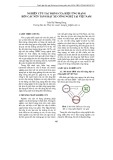

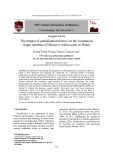

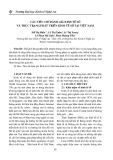
![Kinh tế số Việt Nam: Chính sách và thực thi [Cập nhật mới nhất]](https://cdn.tailieu.vn/images/document/thumbnail/2024/20241028/gaupanda058/135x160/4241730112118.jpg)
